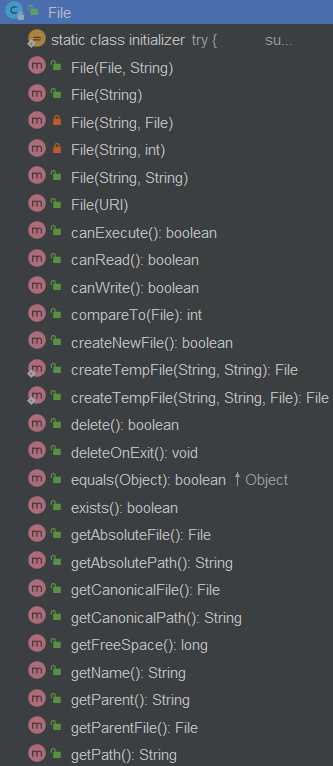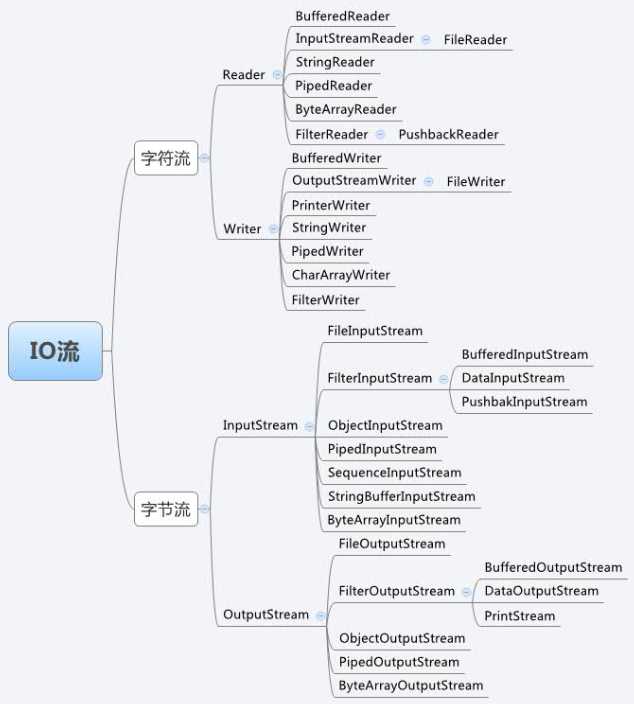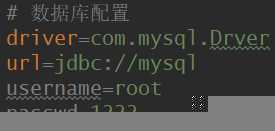Java学习之==>IO文件操作体系
2020-12-13 14:33
标签:ada obj line 分配 基本用法 根据 object 计算 none 一、概述 在整个 Java.io 中最重要的就是5个类和一个接口。5个类指的是 File、InputStream、OutputStream、Reader、Writer,一个接口指的是Serializable。掌握了这些IO的核心操作那么对于Java中的IO体系也就有了一个初步的认识了。 二、File 类 从定义看,File类是Object的直接子类,同时它继承了Comparable接口可以进行数组的排序。File 类的操作包括文件的创建、删除、重命名、得到路径、创建时间等,以下是文件操作常用的函数。 File类是对文件系统中文件以及文件夹进行封装的对象,可以通过对象的思想来操作文件和文件夹。File类保存文件或目录的各种元数据信息,包括文件名、文件长度、最后修改时间、是否可读、获取当前文件的路径名,判断指定文件是否存在、获得当前目录中的文件列表,创建、删除文件和目录等方法。 三、IO流的分类 1、流的概念和作用 Java 中将输入输出抽象称为流,就好像水管,将两个容器连接起来。流是一组有顺序的,有起点和终点的字节集合,是对数据传输的总称或抽象。即数据在两设备间的传输称为流。 2、 IO流的分类 根据数据流向不同分为:输入流和输出流。 根据处理数据类型的不同分为:字符流和字节流。 四、IO流体系结构 如上图所示,正如我们文章开篇讲到的,Java 的 IO 体系最重要的 5 个类,除了 File 类以外,整个 IO 体系将近 50 个类,都是由其余四个类(InputStream、OutputStream、Reader、Writer)派生出来的。但是这四个类都是抽象类,他们当中的绝大部分方法需要通过他们的子类来实现。 1、文件操作流 这四个类是专门操作文件流的,用法高度相似,区别在于前面两个是操作字节流,后面两个是操作字符流。它们都会直接操作文件流,直接与OS底层交互。因此他们也被称为节点流。注意使用这几个流的对象之后,需要关闭流对象,因为java垃圾回收器不会主动回收。 下面演示这四个流对象的基本用法: 2、缓冲操作流 计算机访问外部设备非常耗时。访问的频率越高,造成CPU闲置的概率就越大。为了减少访问外部存储的次数,应该在一次对外部设备的访问中,读写更多的数据。为此,除了程序和流节点间交换数据必需的读写机制外,还应该增加缓冲机制。缓冲流就是每一个数据流分配一个缓冲区,一个缓冲区就是一个临时存储数据的内存。这样可以减少访问硬盘的次数,提高传输效率。 同样,我们来演示一下基本用法: 3、总结 流的基本操作过程: 结论: 五、读取properties文件 Java 中有个比较重要的类 Properties(Java.util.Properties),主要用于读取 Java 的配置文件,各种语言都有自己所支持的配置文件,配置文件中很多变量是经常改变的,这样做也是为了方便用户,让用户能够脱离程序本身去修改相关的变量设置。在Java中,其配置文件常为.properties文件,格式为文本文件,文件的内容的格式是“键=值”的格式,文本注释信息可以用"#"来注释。下面来看一下它的用法: 配置文件内容如下: IO文件操作体系,soscw.com" target="_blank">Java学习之==>IO文件操作体系 标签:ada obj line 分配 基本用法 根据 object 计算 none 原文地址:https://www.cnblogs.com/L-Test/p/11477483.html



private static void demo01() {
File file = new File("/course/test.log");
boolean canRead = file.canRead();
System.out.println("canRead = " + canRead);
boolean canWrite = file.canWrite();
System.out.println("canWrite = " + canWrite);
boolean canExecute = file.canExecute();
System.out.println("canExecute = " + canExecute);
file.setReadable(true);
canRead = file.canRead();
System.out.println("canRead = " + canRead);
}
private static void demo02() {
File file = new File("/course/test.log");
String fileName = file.getName();
System.out.println("fileName = " + fileName);
File fileAbsoluteFile = file.getAbsoluteFile();
System.out.println("fileAbsoluteFile = " + fileAbsoluteFile);
String fileAbsolutePath = file.getAbsolutePath();
System.out.println("fileAbsolutePath = " + fileAbsolutePath);
String fileParent = file.getParent();
System.out.println("fileParent = " + fileParent);
File fileParentFile = file.getParentFile();
System.out.println("fileParentFile = " + fileParentFile);
String filePath = file.getPath();
System.out.println("filePath = " + filePath);
}
private static void demo03() {
File file = new File("/course");
System.out.println("file.isFile() = " + file.isFile());
System.out.println("file.isDirectory() = " + file.isDirectory());
}
private static void demo04() {
File file = new File("/course/test.log");
final boolean exists = file.exists();
System.out.println("exists = " + exists);
boolean canRead = file.canRead();
System.out.println("canRead = " + canRead);
boolean canWrite = file.canWrite();
System.out.println("canWrite = " + canWrite);
boolean canExecute = file.canExecute();
System.out.println("canExecute = " + canExecute);
boolean isFile = file.isFile();
System.out.println("isFile = " + isFile);
boolean isDir = file.isDirectory();
System.out.println("isDir = " + isDir);
}


/**
* 遍历本地一个目录下.找到后缀名是.log的,且占用空间最大的那个文件删除之
* 目录下还有目录,使用递归实现
*/
public class Case1 {
public static void main(String[] args) {
deleteLog("D:\\TestDir",".log");
}
/**
* 遍历目下下的文件,删除指定后缀且文件大小最大的文件
* @param path 遍历目录的路径
* @param endstr 文件后缀
*/
public static void deleteLog(String path,String endstr){
// 定位文件描述
File dir = new File(path);
// 列出该目录下所有的文件对象,存入一个文件对象数组当中
File[] files = dir.listFiles();
// 初始化最大文件对象和最大文件大小
long maxFileSize = 0;
File maxFile = null;
// 遍历文件对象数组
for (File file:files) {
// 如果是文件,则找出指定后缀且大小最大的文件
if (file.isFile()){
long len = file.length();
String fileName = file.getName();
if (fileName.endsWith(endstr)){
if (len >maxFileSize ){
maxFileSize = len;
maxFile = file;
}
}
}
// 如果是目录,则递归调用deleteLog
if (file.isDirectory()){
path =file.getAbsolutePath();
deleteLog(path,endstr);
}
}
if (maxFile != null){
System.out.println("删除"+maxFile.getAbsolutePath()+"文件");
maxFile.delete();
System.out.println("删除成功");
}
else {
System.out.println("未找到目标文件");
}
}
}


/**
* case1: 实现文件复制,从指定位置复制到目标位置.
* 思考,若指定文件不存在?
* 若目标位置文件已存在?
* 若目标位置目录不存在?
* 其他请自行发挥
*/
public class Case3 {
public static void main(String[] args) {
String initialFile = "D:\\TestDir\\1.log";
String targetDir = "D:\\TestDir\\subdir\\1.log";
BufferedReader br = null;
BufferedWriter bw = null;
try {
// 读文件
br = new BufferedReader(new FileReader(initialFile));
String value;
String data = "";
while ((value = br.readLine()) != null){
data += value + "\n";
}
// 写文件
bw = new BufferedWriter(new FileWriter(targetDir));
bw.write(data);
bw.flush();
// 捕获异常
}catch (FileNotFoundException ex){
ex.printStackTrace();
}catch (IOException ix) {
ix.printStackTrace();
}finally {
try {
if (null != br && null != bw){
br.close();
bw.close();
}
} catch (IOException e) {
e.printStackTrace();
}
}
}
}




public class App {
public static void main(String[] args) {
File file = new File("test.log");
try (InputStream ins = new FileInputStream(file)) {
byte[] buf = new byte[512];
int len = 0;
while ((len = ins.read(buf)) != -1) {
String val = new String(buf, 0, len);
System.out.println(val);
}
} catch (IOException ex) {
throw new IllegalStateException(ex);
}
}
}


public class App {
public static void main(String[] args) {
OutputStream outputStream = null;
try {
// 1.定位文件描述
File file = new File("test.log");
// 2.实例化要写文件的基本类FileOutputStream
outputStream = new FileOutputStream(file);
// 3.写数据
String str = "hello world!";
outputStream.write(str.getBytes());
} catch (FileNotFoundException ffe) {
ffe.printStackTrace();
} catch (IOException ioe) {
ioe.printStackTrace();
} finally {
try {
// 4.关流,千万要记得关闭
if (null != outputStream) {
outputStream.close();
}
} catch (IOException e) {
e.printStackTrace();
}
}
}
}


public class App {
public static void main(String[] args) {
FileReader reader = null;
try {
// 1.文件描述
File file = new File("test.log");
// 2.定义文件读取流
reader = new FileReader(file);
// 3.文件读取
char[] buf = new char[4];
// 标准的写法
int len = 0;
while ((len = reader.read(buf)) != -1) {
System.out.println("len=" + len);
// 这里要注意,String的构造,要注意边界
String val = new String(buf, 0, len);
System.out.println(val);
}
// 这里的读取,如果不使用len来进行标识会有问题
// while (reader.read(buf) != -1) {
// String val = new String(buf, 0, buf.length);
// System.out.println(val);
// }
// 理解的读取过程
// while (len != -1) {
// len = reader.read(buf);
// if (len != -1) {
// String val = new String(buf, 0, len);
// System.out.println(val);
// }
// }
} catch (FileNotFoundException fnfe) {
fnfe.printStackTrace();
} catch (IOException ioe) {
ioe.printStackTrace();
} finally {
// 4.关流
if (null != reader) {
try {
reader.close();
} catch (IOException e) {
e.printStackTrace();
}
}
}
}
}


public class App {
public static void main(String[] args) {
FileWriter fileWriter = null;
try {
// 1.定位文件描述
File file = new File("test.log");
// 2.实例化要写文件的基本类FileWriter
fileWriter = new FileWriter(file);
// 3.写数据
String str = "hello world!";
fileWriter.write(str);
} catch (FileNotFoundException ffe) {
ffe.printStackTrace();
} catch (IOException ioe) {
ioe.printStackTrace();
} finally {
try {
// 4.关流,千万要记得关闭
if (null != fileWriter) {
fileWriter.close();
}
} catch (IOException e) {
e.printStackTrace();
}
}
}
}



public class BufferedReaderDemo {
public static void main(String[] args) {
test01("test.log");
test02("test.log");
}
private static void test02(String fileName) {
BufferedReader reader = null;
try {
// 1.文件描述
File file = new File(fileName);
// 2.定义文件读取流
// 使用BufferedReader时,就这里与FileReader不同
reader = new BufferedReader(new FileReader(file));
// 3.文件读取
String val = null;
// 一行一行读取文件内容
while ((val = reader.readLine()) != null) {
System.out.println(val);
}
} catch (IOException ie) {
ie.printStackTrace();
} finally {
// 4.关流
if (null != reader) {
try {
reader.close();
} catch (IOException e) {
e.printStackTrace();
}
}
}
}
private static void test01(String fileName) {
Reader reader = null;
try {
// 1.文件描述
File file = new File(fileName);
// 2.定义文件读取流
// 使用BufferedReader时,就这里与FileReader不同
reader = new BufferedReader(new FileReader(file));
// 3.文件读取
char[] buf = new char[4];
// 标准的写法
int len = 0;
while ((len = reader.read(buf)) != -1) {
System.out.println("len=" + len);
// 这里要注意,String的构造,要注意边界
String val = new String(buf, 0, len);
System.out.println(val);
}
} catch (IOException ie) {
ie.printStackTrace();
} finally {
// 4.关流
if (null != reader) {
try {
reader.close();
} catch (IOException e) {
e.printStackTrace();
}
}
}
}
}


public class BufferedWriterDemo {
public static void main(String[] args) {
File file = new File("test.log");
Writer writer = null;
try {
writer = new BufferedWriter(new FileWriter(file));
String str = "Hello,world!!";
writer.write(str);
}catch (IOException e) {
e.printStackTrace();
} finally {
if (null != writer) {
try {
writer.close();
} catch (IOException e) {
e.printStackTrace();
}
}
}
}
}


public class BufferedInputStreamDemo {
public static void main(String[] args) {
InputStream inputStream = null;
try {
File file = new File("test.log");
inputStream = new BufferedInputStream(new FileInputStream(file));
byte[] bytes = new byte[128];
int len = 0;
while ((len =inputStream.read(bytes)) != -1) {
String val = new String(bytes,0,len);
System.out.println("val = " + val);
}
} catch (IOException e) {
e.printStackTrace();
}finally {
if (null != inputStream) {
try {
inputStream.close();
} catch (IOException e) {
e.printStackTrace();
}
}
}
}
}


public class BufferedOutputStreamDemo {
public static void main(String[] args) {
OutputStream outputStream = null;
try {
// 1.定位文件描述
File file = new File("test.log");
// 2.实例化要写文件的基本类BufferedOutputStream
// outputStream = new FileOutputStream(file);
// 唯一的区别就在这里,把FileOutputStream作为构造的参数传递进去了
outputStream = new BufferedOutputStream(new FileOutputStream(file));
// 3.写数据
String str = "hello world";
outputStream.write(str.getBytes());
} catch (IOException ie) {
ie.printStackTrace();
} finally {
try {
// 4.关流,千万要记得关闭
if (null != outputStream) {
outputStream.close();
}
} catch (IOException e) {
e.printStackTrace();
}
}
}
}
public class PropDemo {
@Test
public void demo1() throws IOException {
Properties prop = new Properties();
// 这里是需要是绝对路径,否则会报错
// File propFile = new File("E:\\Java_Project\\MyProject\\resources\\config.properties");
// prop.load(new FileInputStream(propFile));
// 使用ClassLoader来读取,文件放在resources目录下,路径就可写相对路径
prop.load(PropDemo.class.getClassLoader().getResourceAsStream("config.properties"));
// get:返回的是对象
// getProperty:返回的是字符串
Object driver = prop.get("driver");
String url = prop.getProperty("url");
System.out.println(url);
System.out.println(driver);
}
@Test
public void demo02() throws IOException {
Properties prop = new Properties();
// 使用ClassLoader来读取
prop.load(PropDemo.class.getClassLoader().getResourceAsStream("config.properties"));
prop.setProperty("name", "jim");
String property1 = prop.getProperty("name");
String property2 = prop.getProperty("YY", "abc");
System.out.println(property1);
System.out.println(property2);
}
}

下一篇:02_python的运算符